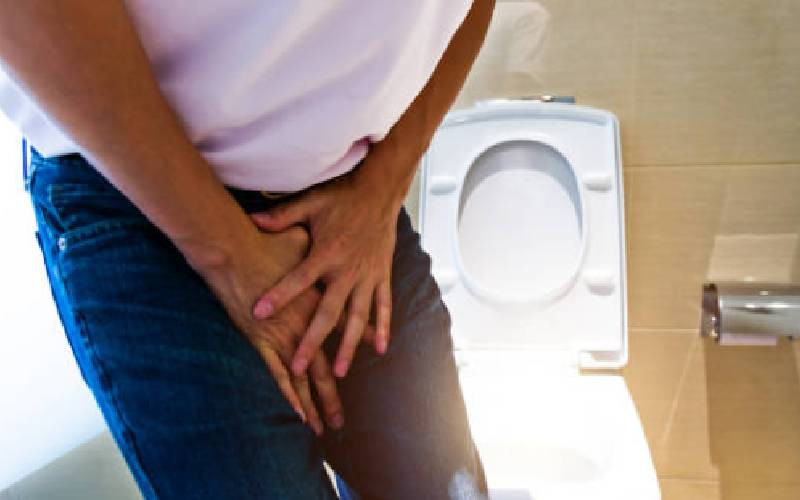
The front page picture of The Star newspaper released into the market on Thursday, January 12, 2023 featured significantly on Kenyans' WhatsApp and social media statuses.
The newspaper's lead story was titled 'Super gonorrhea strikes Nairobians', with the report stating that the Kenya Medical Research Institute (KEMRI) was concerned about the increase in the number of gonorrhea cases that are becoming more difficult to treat among city dwellers.
Typical of Kenyans, they took to social media to warn their friends and followers that reckless sex was becoming costlier by the day.
Many captioned the front-page image with the Swahili words "soko ni chafu", to mean "more and more people have STIs out here", and, therefore, caution is needed when engaging in sexual intercourse, especially with new partners.
The World Health Organization (WHO) said in a recent report that in 2020, there were 82.4 million new gonorrhea infections among adolescents and adults aged 15 to 49 years worldwide, with most of the cases registered in Africa and the western Pacific regions.
Gonorrhea is the second most common bacterial sexually transmitted infection (STI) after chlamydia.
In 2020, the WHO said there were 129 million new chlamydia infections in the world, followed by gonorrhea at 82.4 million.
In total, there were 374 million new STIs registered that year, with trichomoniasis leading with 156 million cases. Syphilis new infections that year were 7.1 million globally.
The WHO says that more than one million STIs are acquired every day worldwide, the majority of which are asymptomatic.
Gonorrhea, one of the commonest STIs in Africa, is caused by the bacterium Neisseria gonorrhoeae.
It infects the mucous membranes of the reproductive tract, including the cervix, uterus, and fallopian tubes in women, and the urethra in women and men.
The bacterium can also infect the mucous membranes of the mouth, throat, eyes, and rectum.
Symptoms
The Centers for Disease Control and Prevention (CDC) says gonorrhea is transmitted through sexual contact with the penis, vagina, mouth, or anus of an infected partner.
Ejaculation does not have to occur for gonorrhea to be transmitted or acquired. Gonorrhea can also be spread perinatally from mother to baby during childbirth.
The signs of gonorrhea infection among men include a white, yellow, or green smelly urethral discharge that usually appears one to 14 days after infection, a burning pain when passing urine, testicular or scrotal pain.
Most women with gonorrhea are asymptomatic. Even when a woman has symptoms, they are often so mild and nonspecific that they are mistaken for a bladder or vaginal infection, the CDC says.
The initial symptoms in women include increased vaginal discharge, or vaginal bleeding between periods. Women with gonorrhea are at risk of developing serious complications from the infection, regardless of the presence or severity of symptoms, says the CDC.
Serious health problems
Untreated gonorrhea can cause serious and permanent health problems in both women and men.
In women, gonorrhea can spread into the uterus or fallopian tubes and cause pelvic inflammatory disease, which can lead to internal abscesses and chronic pelvic pain. PID can also damage the fallopian tubes enough to cause infertility or increase the risk of ectopic pregnancy.
In men, untreated gonorrhea may lead to infertility. It can also spread to the blood and cause arthritis, tenosynovitis, and/or dermatitis, which can be life-threatening, says the CDC.
Gonorrhea can be diagnosed by testing urine, urethral specimen for men, or endocervical or vaginal specimen for women. It can also be diagnosed using gonorrhea culture, which requires endocervical or urethral swab specimens.
'Super gonorrhea'
Gonorrhea treatment has been effective over the years, though of late, the disease has become more resistant to drugs.
Dr. Teodora Wi, the WHO Medical Officer specialising in STIs, says the drug-resistant gonorrhea is now famously known as super gonorrhea.
"When we say 'super gonorrhea' we mean 'gonorrhea superbug'. These are extensively drug-resistant gonorrhea with high-level resistance to the current recommended treatment for gonorrhea (ceftriaxone and azithromycin) including resistance to penicillin, sulphonamides, tetracycline, fluoroquinolones, macrolides," said Dr. Wi as quoted by the WHO official website.
Why gonorrhea is resisting treatment
According to Dr. Wi, there are five reasons for the increased drug-resistance in gonorrhea treatment.
The reasons are unrestricted access to antimicrobials (products that kill or slow the spread of microorganisms), inappropriate selection and overuse of antibiotics, poor quality antibiotics, inherent genetic mutations within the organism which have contributed to the development of a pattern of resistance, and extra-genital infections (infections in the anus, throat and eyes).
Compared to other STIs such as syphilis, gonorrhea has the highest level of drug-resistance, the WHO says.
"The first line treatment of Benzathine penicillin remains highly effective, there has been evidence of resistance to azithromycin," said Dr. Wi.
Dr. Wi further said gonorrhea is extremely cruel to the reproductive system if left untreated.
If left untreated, gonorrhea exposes one to a five-fold increase of HIV transmission, infertility, inflammation; leading to acute and chronic lower abdominal pain in women, ectopic pregnancy and maternal death, first trimester abortion; and severe neonatal eye infections that may lead to blindness, said Dr. Wi.
Adults with gonorrhea are treated with a combined dose of antibiotics. Due to emerging strains of drug-resistant gonorrhea, the CDC recommends that uncomplicated gonorrhea be treated with the antibiotic ceftriaxone - given as an injection - with oral azithromycin (Zithromax).
If you're allergic to ceftriaxone, you might be given oral gemifloxacin (Factive) or injectable gentamicin and oral azithromycin.
"Increasing resistance to the last-line treatment for gonorrhea, poses a big challenge because it limits the treatment choices available for gonorrhea infections. The development of resistance clearly outpaces the development of new antibiotics. There is an urgent need to develop new treatment options for gonorrhea," says WHO's Dr. Teodora Wi.
Using a condom or other barrier method when engaging in sex can help lower one's chances of transmitting or contracting gonorrhea.
These barrier methods, however, won't always completely eliminate the risk of infection, especially if they aren't used properly.
 The Standard Group Plc is a multi-media organization with investments in media platforms spanning newspaper print
operations, television, radio broadcasting, digital and online services. The Standard Group is recognized as a
leading multi-media house in Kenya with a key influence in matters of national and international interest.
The Standard Group Plc is a multi-media organization with investments in media platforms spanning newspaper print
operations, television, radio broadcasting, digital and online services. The Standard Group is recognized as a
leading multi-media house in Kenya with a key influence in matters of national and international interest.











